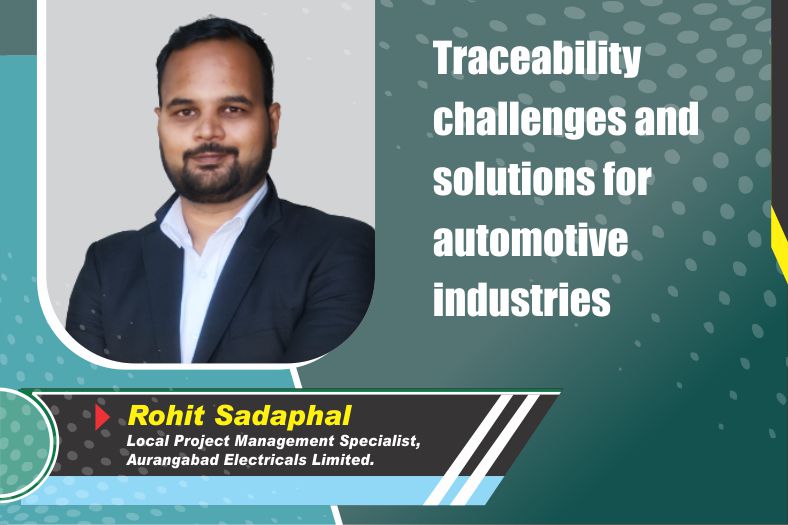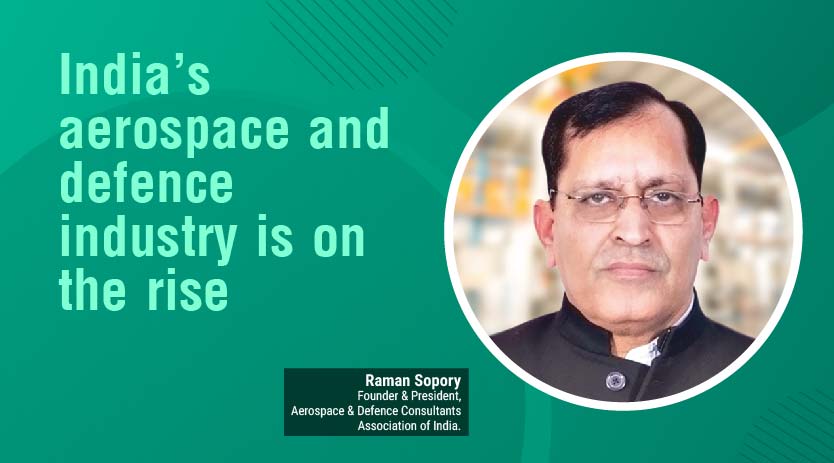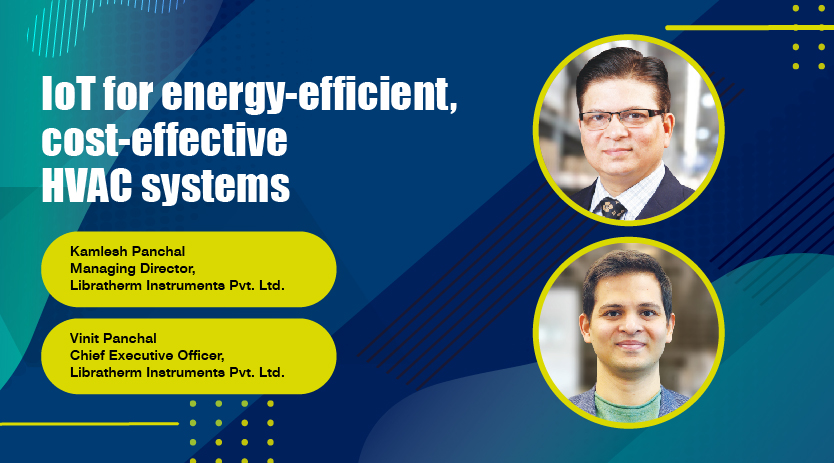Traceability challenges and solutions for automotive industries
March 1, 2022 7:08 pm
Traceability helps in gathering the big data, and correlating this big data with the product you’re going to manufacture.
We all have undergone radical change during the pandemic times and that really challenged our skill set towards agility and adaptability in the pandemic times. The organisations which were ready with the industry 4.0 ecosystem and digital transformation ecosystems, they all managed and could leverage from this age and could perform better with respect to their peers and ultimately, the market requirements. So, when we talk about traceability or trace and ability, you have to decode this stuff.
Traceability means like trace and ability
The definitions can be different for different industries like pharma, agri goods, electronic components and others like even real estate and pharmaceuticals as well. When we talk about digitalisation, digitisation and digital transformation, these three are different terms. Digitisation means we are converting the devices from analog to digital. That was an era a few years ago. Then we moved to digitalisation where our mail exchanging and instant messaging came into place. So digitalisation over function is what is demanding digital transformation. Digital transformation and digital twin Digital transformation means creation, the data when it is being exchanged, it should be more relevant and be able to convert into a creation. So that’s how digital transformation comes into place. One of the greatest examples is having a digital twin which is also an excellent digital asset for most of the companies, not just limited to the software industry. Now it has been extended to manufacturing agri and multiple sectors.
When we talk about traceability, this is not like jargon or something. But we all know in India that Mumbai dabbawalas were the first to introduce the traceability to their customised solutions in Mumbai. And they were doing it very perfectly.
The demand traceability has been an edge for most of these startup companies or, we can say for most of the startup unicorns. This has been a real edge. If the customers or users are able to experience how the product is being handled and if they are able to see it reading the traceability, that exactly has been a greater edge for most of these startups’ success. And later, if we talk about vaccines, like vaccine traceability, the beneficiaries’ liability has been one of the common terms when we talk about traceability for the automotive sector.
Challenges in automotive traceability
For auto component manufacturing, we do supply to most of the tier-I OEMs in India as well as globally. Regarding the challenges that automotive companies are facing probably; the first challenge that an automotive industry faces is about the customer acceptance of the product. At times, we see a large volume of vehicles being recalled to address specific specifications. We have seen the world has gone through these things like a lot of vehicles were being recorded. So at such times, we need to have a clear traceability of the product that we are manufacturing. Likewise, we should have traceability from raw material sourcing to the final dispatch of the product. To have this traceability, the next challenge that we face is vulnerability in several processes because our processes about automotive are rugged enough. So, we need to have some press marks which are rugged enough to press in everything like traceability from solid raw material to liquid raw material, from liquid raw material to high pressure die casting and then further into machining, heat treatment and other processes. So, this has been a primary challenge for auto component manufacturing industries, like implemented repeating itself in discrete patterns, it has been implemented for different solutions, but as a complete, like what we see as lifecycle from cradle to grave, that’s from raw material to dispatch, it still remains a challenge for an industry. The next big challenge for the auto component industry is e-vehicles. When we say e-vehicles the moment we can link it to the digitalisation because the moment you say, we are available with the e-vehicles. The e-vehicles will not be just e-vehicles, they will be connected vehicles, which will have a lot of data inside them. There will be a company which will be mapping all of your data like how the performance of engineering is going and there will be a lot of analytics. That means if something goes as a failure towards Indian performance or something, we all have undergone radical change during the pandemic times and that really challenged our skill set towards agility and adaptability in the pandemic times. The organisations which were ready with the industry 4.0 ecosystem and digital transformation ecosystems, they all managed and could leverage from this age and could perform better with respect to their peers and ultimately, the market requirements. So, when we talk about traceability or trace and ability, you have to decode this stuff. Traceability means like trace and ability The definitions can be different for different industries like pharma, agri goods, electronic components and others like even real estate and pharmaceuticals as well. When we talk about digitalisation, digitisation and digital transformation, these three are different terms. Digitisation means we are converting the devices from analog to digital. That was an era a few years ago. Then we moved to digitalisation where our mail exchanging and instant messaging came into place. So digitalisation over function is what is demanding digital transformation.
Digital transformation and digital twin
Digital transformation means creation, the data when it is being exchanged, it should be more relevant and be able to convert into a creation. So that’s how digital transformation comes into place. One of the greatest examples is having a digital twin which is also an excellent digital asset for most of the companies, not just limited to the software industry. Now it has been extended to manufacturing agri and multiple sectors. When we talk about traceability, this is not like jargon or something. But we all know in India that Mumbai dabbawalas were the first to introduce the traceability to their customised solutions in Mumbai. And they were doing it very perfectly. The demand traceability has been an edge for most of these startup companies or, we can say for most of the startup unicorns. This has been a real edge. If the customers or users are able to experience how the product is being handled and if they are able to see it reading the traceability, that exactly has been a greater edge for most of these startups’ success. And later, if we talk about vaccines, like vaccine traceability, the beneficiaries’ liability has been one of the common terms when we talk about traceability for the automotive sector. Challenges in automotive traceability For auto component manufacturing, we do supply to most of the tier-I OEMs in India as well as globally. Regarding the challenges that automotive companies are facing probably; the first challenge that an automotive industry faces is about the customer acceptance of the product. At times, we see a large volume of vehicles being recalled to address specific specifications. We have seen the world has gone through these things like a lot of vehicles were being recorded. So at such times, we need to have a clear traceability of the product that we are manufacturing.
Likewise, we should have traceability from raw material sourcing to the final dispatch of the product. To have this traceability, the next challenge that we face is vulnerability in several processes because our processes about automotive are rugged enough. So, we need to have some press marks which are rugged enough to press in everything like traceability from solid raw material to liquid raw material, from liquid raw material to high pressure die casting and then further into machining, heat treatment and other processes. So, this has been a primary challenge for auto component manufacturing industries, like implemented repeating itself in discrete patterns, it has been implemented for different solutions, but as a complete, like what we see as lifecycle from cradle to grave, that’s from raw material to dispatch, it still remains a challenge for an industry.
The next big challenge for the auto component industry is e-vehicles. When we say e-vehicles the moment we can link it to the digitalisation because the moment you say, we are available with the e-vehicles. The e-vehicles will not be just e-vehicles, they will be connected vehicles, which will have a lot of data inside them. There will be a company which will be mapping all of your data like how the performance of engineering is going and there will be a lot of analytics. That means if something goes as a failure towards Indian performance or something, in such cases, we need to have real time traceability of the products which are going in the making of this vehicle.
On another front, this data will also help to be able to correlate with the traceability and will also help us with the continual improvement of this entire vehicle. So, no traceability in a different way can also be linked to perpetual learning and implementation on different designs, processes and products. Traceability helps in gathering the big data, and correlating this big data with the product you’re going to manufacture.
Material traceability is becoming more relevant, because we are living in a finite world. So the materials are quite finite, and most of the time we use recycled materials. So the big challenge with recycled materials is that it is very diverse. And it has a lot of variety to it. When we say variety, a different quality of materials is available. So for raw materials if you’re three or four grades, when we switch to recycling materials, we could have 100 plus grades of things. So when we deal with such big data and things and with a common manufacturing practice, we need to have a traceability of what from where it came into things. Next biggest thing is like we are dealing with the global markets.
If something is being produced in India, it is being assembled in Germany and being sold in the USA. So we are living in a very global supply chain, if something goes wrong in the USA to be able to trace back to the manufacturing and to be able to trace back to raw material. We should have this entire traceability so that not all of the vehicles have been called out but specific vehicles have been called. One of the prime areas for any company in today’s world is mapping the efficiency and productivity of all of their efforts, not just the humans but also the machines, the processes and designs.
Asset tracking
Asset tracking has been one of the things, so most of the Indian startups are doing with this asset tracking and now with the help of leapfrogging they are able to put some barcodes and stickers on the new and GPS tags on the assets. And they are able to trace exactly the tool title and big assets. So that challenge has been overcome by most of the industries, even in our industry, we have implemented successfully. So we are able to tag all of our assets. And in real time, we can reconcile all of these things. Like we talked about the machines and tools and titles, importantly, visitors visiting the campuses are also important for any manufacturing industry. So we have implemented a visitor management system. We are trying to trace the people who are working in our company and where they’re visiting. So it’s much simpler. We can just put up a GPS tag or their cards and then see what the moment is and where they visited, how they visited and what the pattern is. In A similar way we are also tracking our assets, it is not a new thing, that concept came like two decades back. But same thing, we are doing a horizontal deployment to the human aspect as well. Talking about the solutions, not just the challenges from the automotive side, like component manufacturing.
In auto component manufacturing industry, or for that matter, any of the industries, we are living in smart and connected manufacturing. So at times to be more efficient to be productive, you do district setups because you’re to improve efficient practice and innovation. And you want to leverage on your core aspects of sports skills and core values. So you go into district setup. When you go into district setup, different ecosystems, partners are manufacturing a single product with different outputs. Then traceability is important, because at the end of the day, we need to know what went wrong with the exact process on which product. Traceability at times is not a big thing like nowadays, like the only thing is we need to secure it properly. Blockchain is an upcoming era, AI and block chain implementation. So one can also look at the inventory mapping in real time. With the help of AI implementation block chain implementation, and then accordingly can manufacture their products so that they are not carrying a lot of inventory along with them.
The next is the RFID and GPS tags. Most industries still need to implement RFID, GPS and QR code implementations. 10 years back, it was difficult for everyone to carry the maps, plans and details about the quality test for each of the floors in a building. We put everything into a single cloud storage device. And then from that device, there was QR code which was generated, which was pasted on each floor. So whenever the technical person or even our structural engineer visited, they used to just simply scan these things. This was 10 years back, they used to get this data, as simple as getting the traceability can be done, and as complex as we can make it to the block chain.
It is complex on the part of a designer, but on a part of the user, it’s much simpler, but it gives the right data at the right time, which is encrypted. Vision cameras are also playing a lot in this case. We used to have static cameras which were being utilised to identify the quality defects of their vision, which enabled cameras, we are tracing everything. Now from the defects to everything, they are able to correlate with the processes and the design concludes Rohit.
Cookie Consent
We use cookies to personalize your experience. By continuing to visit this website you agree to our Terms & Conditions, Privacy Policy and Cookie Policy.

















 English
English Hindi
Hindi